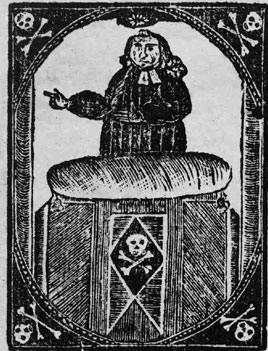Study Guide Death

Table of Contents
Funeral Sermons
 Funeral sermons provided an opportunity for ministers to help their congregants mourn and to prepare them for their own eminent departure from the world of the flesh. Mayhew includes a number of Wampanoag funeral sermons in Indian Converts. Before 1660, most funeral sermons were given for prominent citizens, however as the century progressed sermons became more popular for commoners as well, including criminals (Bosco 4. xii). Funerary sermons often followed the same eighteenth-century Protestant sermons had a triadic structure: Text (or Doctrine), Explication (Reason), and Application (Use). If elegies help the reader mourn by substituting language for the dead, funerary sermons help the reader mourn by transforming the dead into a saint or sinner: that is, the sermons assuage the mourner’s fears of death or sense of loss by insisting upon the eternal life of the deceased.
Funeral sermons provided an opportunity for ministers to help their congregants mourn and to prepare them for their own eminent departure from the world of the flesh. Mayhew includes a number of Wampanoag funeral sermons in Indian Converts. Before 1660, most funeral sermons were given for prominent citizens, however as the century progressed sermons became more popular for commoners as well, including criminals (Bosco 4. xii). Funerary sermons often followed the same eighteenth-century Protestant sermons had a triadic structure: Text (or Doctrine), Explication (Reason), and Application (Use). If elegies help the reader mourn by substituting language for the dead, funerary sermons help the reader mourn by transforming the dead into a saint or sinner: that is, the sermons assuage the mourner’s fears of death or sense of loss by insisting upon the eternal life of the deceased.
Samson Occom’s A Sermon Preached at the Execution of Moses Paul is the most famous extant sermon by a Native American minister from the British colonies. This sermon provides a useful counterpoint for Mayhew’s sermons both in terms of form and the use of the figure of the Indian. While the funerary sermons in Mayhew’s text create a sense of community out of the mourners by aligning the survivors with the idealized deeds of dead, execution sermons create community through opposition to the sins of the dead. Most surviving colonial funerary sermons for Native Americans, with the exception of those in Indian Converts, were given at the execution of a Native American convicted of crimes. The execution sermons underwent significant alterations towards the end of the eighteenth-century: while earlier execution sermons focused upon the crimes of cultural insiders in order to address the community's spiritual declension, late eighteenth-century execution sermons tended to focus upon the misdeeds of cultural outsiders: "blacks, Indians, Irishmen,...foreign pirates" and the like (Ruoff 941; Bosco 1. lxxiii-lxxvi; Cohen 78-79, 123) (1). Indeed, trials and executions became a means of expression social tensions as eighteenth-century New England society became increasingly pluralistic (Cohen 30). This shift suggests that New England citizens no longer viewed the criminals as representative of the sinful state of their own community, but as indicative of the "sores" cultural others--such as drunken Indians--inflicted upon the body politic (2). By choosing St. Paul’s Epistle to the Romans as his central biblical text, Occom is able to redraw American Indian identities in three central ways: he reconfigures American Indians as insiders within God's spiritual community, he undermines white attempts to use American Indians as scapegoats, and he addresses white hypocrisy.
Examples of Funerary Sermons included in Indian Converts can be found on pp. 105-106 and 142-43 of the University of Massachusetts Press edition.
Notes
(1) For an extensive discussion of early New England funeral sermons, see the Introduction to Ronald Bosco's The Puritan Sermon in America, 1630-1750, Vol I: Sermons for Days of Fast, Prayer, and Humiliation and Execution Sermons (lxxiii-lxxxiv).
(2) Even missionaries often considered unconverted and recalcitrant Indians as wounds to the New England body of Christ: Occom's teacher Eleazar Wheelock advocated Indian schooling by arguing that, it was "[A]front of divine Dispensations; from Year to Year, in permitting the Savages to be such a sore and Scourage to our Land" (Wheelock 11).
Items Related to Funeral Sermons in the Archive
Gravestones < Previous | Next > Mourning Rings